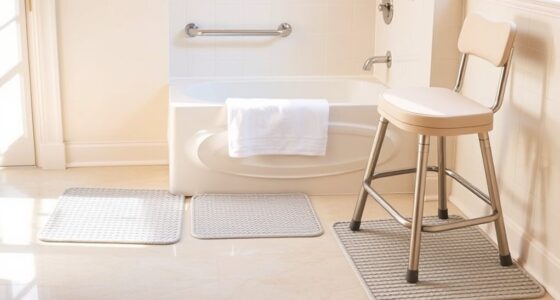Choosing the right cane or walker depends on your stability needs, environment, and comfort. Look for devices with features like adjustable height, ergonomic handles, and non-slip tips to enhance safety and ease of use. If you plan to walk outdoors or on uneven terrain, opt for sturdier walkers with larger wheels. For indoor use, lightweight and maneuverable options work best. Exploring these factors further will help you find the most suitable aid for your mobility.
Key Takeaways
- Prioritize stability features like wide rubber tips or multiple contact points for secure support.
- Choose ergonomic handles that conform to your grip to reduce fatigue and discomfort.
- Consider your environment—outdoor terrain needs sturdy walkers with larger wheels, indoor use favors lightweight canes.
- Ensure adjustable height settings for proper posture and easy customization to your body.
- Select devices that are easy to operate and transport to promote consistent use and independence.

Adaptive walking aids have revolutionized mobility for individuals with balance, strength, or gait challenges. When selecting a cane or walker, your goal is to enhance stability and confidence while maintaining independence. The key lies in understanding how different features contribute to your safety and comfort. One of the most critical factors is stability improvement. A well-designed aid provides a steady support base, reducing the risk of falls. For example, canes with a wide, non-slip rubber tip help you maintain balance on various surfaces, while walkers with multiple points of contact offer a more stable platform. You should look for aids that distribute your weight evenly and prevent wobbling, especially if you experience unsteady gait or weakness.
Choose stability-focused walking aids with wide, non-slip tips or multiple contact points for safer, more secure mobility.
Ergonomic design also plays a crucial role in choosing the right device. An ergonomic walking aid minimizes strain on your hands, wrists, and arms, making it easier to use for extended periods. Handles that conform to your grip reduce discomfort and fatigue, which is particularly important if you have arthritis or limited hand strength. Adjustable height features ensure the aid aligns with your body, promoting proper posture and reducing strain on your back. When you select a cane or walker with ergonomic considerations, you’re investing in a device that feels natural and comfortable, encouraging consistent use and improving overall mobility.
It’s important to think about how your environment and lifestyle influence your choice. For instance, if you mostly walk indoors on smooth surfaces, a lightweight cane with a comfortable grip might suffice. However, if you frequently navigate uneven outdoor terrain, a sturdy walker with larger, rubberized wheels could provide better stability. Consider the weight and portability of the aid as well. You want something that’s easy to carry or fold away when not in use, without sacrificing durability or support.
Another aspect to keep in mind is the ease of use. Your walking aid should be simple to adjust and operate. Features like quick-release mechanisms or adjustable height settings make it easier to customize the device to your needs. When you choose an aid with intuitive design, you’re more likely to use it consistently, which ultimately leads to improved safety and mobility. Additionally, being aware of resources and tools available can help you select the most suitable device for your needs, ensuring better support and confidence in your daily activities. Remember, the right adaptive aid isn’t just about the latest technology; it’s about finding a device that fits your body, supports your movements, and seamlessly integrates into your daily routine.
Frequently Asked Questions
How Do I Measure for the Correct Cane or Walker Height?
To measure for the correct cane or walker height, stand upright with your arms relaxed at your sides. The top of the cane or walker should align with your wrist crease. Confirm the ergonomic handle design feels comfortable and natural. Also, check the weight capacity considerations to match your needs. Adjust the height as needed for maximum support, preventing strain and promoting proper posture during use.
Can I Use a Cane or Walker on Uneven Terrain?
Moving uneven terrain with a cane or walker isn’t a walk in the park, but it’s doable with the right tools. Use a cane or walker with wide, sturdy bases designed for terrain navigation to improve stability enhancement. Consider a model with adjustable height and rugged tips for better grip. Always test your aid on different surfaces first, ensuring it provides the support you need without risking falls or slips.
Are There Stylish or Discreet Options Available?
Yes, you can find stylish and discreet options that suit your fashion sense. Many brands offer walking aids with sleek, modern designs and discreet features, allowing you to maintain your personal style. Look for canes and walkers with fashionable accessories, subtle finishes, and lightweight materials. These options help you feel confident and comfortable, blending functionality with elegance, so your mobility aid complements your look without drawing unnecessary attention.
How Do I Maintain and Clean My Walking Aid?
You should follow regular cleaning routines to keep your walking aid in top shape. Use a damp cloth and mild soap to wipe down the surfaces, avoiding harsh chemicals. Check for loose parts and tighten them as needed, and inspect the rubber tips or wheels for wear and replace if necessary. Maintenance tips also include keeping the frame dry and storing it in a cool, dry place to prevent rust and damage.
When Should I Consider Switching to a Different Mobility Aid?
In the blink of an eye, if your current aid no longer supports your elderly independence or mobility improvements, it’s time to think about switching. When you notice increased difficulty walking, pain, or instability, a different mobility aid might better suit your needs. Don’t wait until falls or injuries occur—regularly assess your comfort and safety, and consult your healthcare provider to make sure you maintain ideal mobility and independence.
Conclusion
Choosing the right cane or walker might seem simple, but it’s more about safety than style. Ironically, the very aid designed to keep you steady can sometimes make you feel more vulnerable. So, take the time to pick wisely—you’ll walk taller knowing you’re truly supported. After all, it’s not just about mobility, but reclaiming independence, even if it means sometimes leaning on a little extra help. After all, what’s more empowering than knowing you’re in control?









